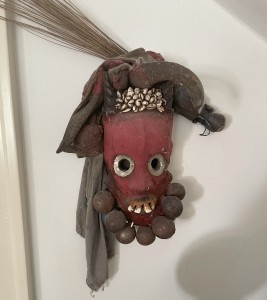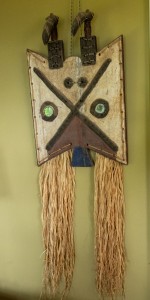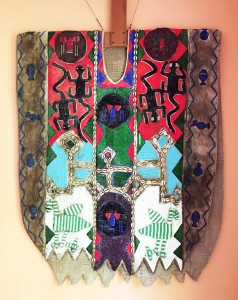These three items from the personal collection of Kathryn Roe will be for sale at the 21st Annual Anansi Auction on Saturday, October 4 (click here for event details). Kathryn’s appreciation of West African art is what first brought her to Cote D’Ivoire and then Ghana, years before founding Anansi Education. Since the first Anansi art auction in 2025, Kathryn has curated art each year to bring from Ghana. These museum-quality pieces have been in Kathryn’s personal collection for decades and are among her favorite representations of West African art.

Zakpai Ge (Dan Policeman’s Mask)
$10,000.00
This commanding mask is a classic example of a Zakpai Ge, also known as a “policeman’s mask,” from the Dan people of West Africa. Such masks are not spiritual intermediaries but function as agents of community law and order, often patrolling villages to enforce rules during public festivals or ceremonial periods.
The mask is characterized by its bold red pigmentation—symbolizing danger, authority, and vigilance—along with large, round eyes that suggest constant awareness. Prominent carved teeth and a dramatic lower border of spherical objects enhance its intimidating expression. The elaborate headdress, composed of layered fabrics, a crown of cowrie shells (symbols of wealth and protection), and other accreted materials, denotes ritual potency and social rank. Zakpai Ge masks are typically worn with full costumes and are
accompanied by forceful movement, drumming, and sometimes spoken proclamations. The mask wearer, often part of a male
society, acts as a visible enforcer of norms, using the mask’s visual and performative power to command respect and compliance.

Bwa Plank Mask
$7,000.00
This striking geometric mask is a classic example of a Bwa plank mask, often referred to as a “butterfly mask” due to its broad, wing-like form and symmetrical design. Used in ceremonies by the Bwa people of Burkina Faso and Mali, these masks serve spiritual and social functions during initiation rites, funerals, and agricultural festivals.
The bold black X design across the face symbolizes the path of the ancestors or the crossing of life and death. Circular eye motifs, inset with reflective materials or shells, are believed to possess the power to see into the spiritual world. The addition of tall, abstract horn-like elements and long raffia fiber extensions enhances the mask’s dramatic effect when worn in dance.
Traditionally, the mask is animated during masquerade performances accompanied by music and community gatherings. It is worn with a full-body regalia made of raffia, hiding the dancer’s identity.

Yoruba Beaded Cloak
$8,000.00
This elaborately adorned beaded tunic, also known as an agbada or ceremonial robe, was created by Yoruba artisans
for a high-ranking chief or ritual leader. The garment is richly decorated with intricate beadwork forming symbolic imagery
and vibrant geometric patterns in bold red, green, blue, white, and black hues. Prominent on the robe are stylized figures,
chameleons, abstract human forms, and esoteric symbols, all densely embroidered in glass seed beads.
Beaded garments of this kind are markers of prestige and sacred authority in Yoruba culture. The central cross-like motif,
bordered with cowrie shells—a traditional symbol of wealth and spiritual power—may represent crossroads, divine guidance, or
the king’s power to mediate between realms. The twin lizard figures at the base symbolize adaptability, duality, and mystical
protection. Vertical motifs and symmetrical balance indicate harmony and cosmic order.
Only the most elite, often members of royal courts or powerful religious societies, are entitled to wear such garments. They are
worn during important ceremonies, festivals, and initiations, where visual spectacle reinforces social hierarchy and ancestral lineage.
